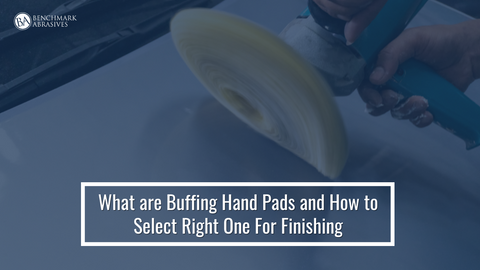
What are Buffing Hand Pads and How to Select Right One For Finishing

Buffing pads are necessary if you wish to keep your car's paint looking glossy or return it to its original appearance. Weather, wear, and accidental scuffs or scratches cause car paint to become dull over time. Buffing hand pads can even be used to fix scratches in addition to polishing and cleaning your car's exterior.
Buffing pads come in a wide range of varieties and pricing points to suit any budget. We've put up this guide to help you understand buffing pads and make an informed purchase so you can get the best ones for you.
BUFFING PADS: WHAT ARE THEY?
Round tools called buffing pads are used to clean paint and other hard materials like metal. The most popular materials for them are microfiber, wool, and foam. While some pads attach to power tools, others are designed to be used manually. They are also helpful for sealing or applying wax.
The way buffing pads remove dirt and leave surfaces smooth and even is comparable to that of fine sandpaper. Using buffing hand pads is a good idea for applying polish or wax to a surface since they are flexible and absorbent and create a barrier of protection between your hand and the surface and material you are applying.
The following are the advantages of buffing pads over other materials:
- ELIMINATES SCRATCHES - When it comes to polishing surfaces, buffing pads work better than towels or other applicators at removing flaws.
- DISTRIBUTES THE PRODUCT EQUALLY - The distinctive design of buffing pads allows for the uniform application of polish, wax, and other finishes to a surface.
- REDUCES PRODUCT USAGE - A buffing pad uses less polish than a towel or other applicator, which might result in cost savings.
HOW DO YOU SELECT BUFFER PADS?
Take into account the following while buying buffing pads:
- MATERIAL - There are several materials used to make buffing hand pads. To choose the ideal material, take into account how the pad will be used and against what surface.
- ADAPTABILITY - The degree of flexibility required for your buffing pads can vary based on the edges and curves of the surface you intend to utilize the product. Rigid pads work well on a level surface, but the surface of your car needs a flexible pad.
- CUT - The way a pad is cut describes how its flaws are eliminated. While less aggressive pads require more buffing time and produce a smoother surface, aggressive pads can remove deep scratches and flaws in paint rapidly. If buffing pads are used to apply wax, a cut-free pad is required to prevent excessive surface roughness.
- SURFACE PAINT - Think about the paint on the surface that you intend to polish using a buffing hand pad. Manufacturers advocate utilizing different buffing pads for different paint types, such as dark paint and clear coatings.
- SURFACE AREA - Think about how big the surface is that you want to buff with the pads. This can assist you in figuring out what size pad to purchase. If you use a polisher or sander, the pad needs to fit your instrument better.
- BUFFING APPARATUS - Make sure the buffing pads are compatible with the power tool you currently own, such as a sander, if you use one for buffing. In order to attach the buffing pads to the sander or polisher, it's also critical that they include a backing pad.
- WARRANTY - A buffing pad with a manufacturer's warranty might be what you're looking for. This could safeguard you in the event that the product is defective and help ensure the quality of the buffing pads.



































































